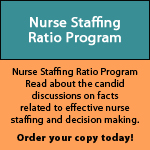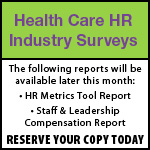ASHHRA eNews Pulse
ASHHRA
ASHHRA e-News Brief: June 2012June 10th we had a heat advisory in South Texas and spent most of the day at over 100 degrees... in June! The only people enjoying the warm weather were those spending their weekend at the beach or in their swimming pool. That means it’s also swimsuit season. Yikes! This is the time when we look back on the past 12 months and wish we had eaten a little healthier and exercised a little longer on the treadmill. Most of us look in the garage for the bike we haven’t used or the golf clubs in the corner and set our summer resolution to eat healthier and get some outdoor exercise. Improving our health becomes our new motto.
For our three ASHHRA at-large board members, however, a culture of health is a year round activity. Nicole Morin-Scribner, director, Human Resources at St. Mary’s Health System in Lewiston, Maine; Amy Barry, system vice president, Human Resources at Palmetto Health Corporate Offices in Columbia, S.C.; and Paul Morlock, vice president, Human Resources at Stanly Regional Medical Center in Albemarle, N.C., regularly think, breathe, and advocate for a year-round culture of health sponsored by our hospitals and health care organizations. Jeff Payne, former board member and president of ASHHRA, kicked this initiative off by collaborating with the American Hospital Association on a Call for Action: Creating a Culture of Health white paper that was sent to all of our members in January of 2011. Nicole, Amy, and Paul have continued this worthwhile cause. Together with the ASHHRA staff, Ursula Pawlowski, HR membership specialist, and Ferdinand Libunao, marketing and communications specialist, they have created a Wellness Toolkit that is a how-to guide for Creating a Culture of Health. Where do you start? How do you justify any expenses to your administrator? What are best practices? All of this can be found in the first document of the toolkit, Creating a Culture of Health. It is replete with ideas that are actionable and currently in use throughout the country by our HR peers. Plus, the data is all there to support the investment.
The ASHHRA Wellness Toolkit also includes how to plan a health awareness day, health week events, and a health and wellness calendar. There are also white papers on Building Strong, Mutual Respectful Relationships with Employees, Building Work Environments that Engage, and Put Employee Wellness Front and Center. The articles are rounded out by more articles on Driving a Culture of Health and An Unhealthy Workforce: Solving America’s Health Care Crisis Starts with Health Care Workers. Even if you think it’s been tried before, check out the toolkit. You’ll be amazed at what your peers are accomplishing in the area of health and wellness.
What are your plans for September? Are you ready to build a culture of health in your organization? If your answer is yes then you need to make plans to attend the ASHHRA Annual Conference in Denver. Come and meet Nicole, Amy, and Paul. Let them introduce you to the world of wellness and all the great activities you can host for your employees. Begin your wellness journey with ASHHRA. Join us in Denver from September 22-25. Hope to see you there!!!
Leading People Through Change,
Irma L. Pye, SPHR
ASHHRA 2012 President
Senior Vice President & CHRO
Valley Baptist Health System
Harlingen, Texas
Visit http://www.naylornetwork.com/ashhramobile/ to view the full article online.
Visit http://www.ashhra.org/advocacy/resources.shtml#aha_legislative_resources to view the full article online.
Visit http://www.ashhra.org/advocacy/position.shtml to view the full article online.
Physicians historically have enjoyed state protections when discussing a colleague’s behavior or analyzing an adverse event in peer review committees. At least 45 states prevent disclosure of what is said during such meetings to facilitate open communication and foster better health care. But a recent rise in legal challenges against peer review protections is putting doctors’ confidentiality—and the process itself—at risk, legal experts and physicians say.
SOURCE: AMEDNEWS.COM
Visit http://www.ama-assn.org/amednews/2012/05/28/prl20528.htm to view the full article online.
The health care sector created 32,800 jobs in May—accounting for 47.5 percent of the 69,000 new jobs in the larger economy for the month, new federal data shows.
SOURCE: HEALTHLEADERS MEDIA
Visit http://www.healthleadersmedia.com/content/HR-280847/Healthcare-Drives-US-Job-Growth-in-May to view the full article online.
At a community hospital board meeting a few years back, Connie Curran, R.N., faced a challenge that as a nurse and former CNO she was unusually qualified to address. Facing declining revenues, the CEO proposed closing the hospital pharmacy on weekends. The board was ready to go along when Curran, the only board member with front-line clinical experience, asked: If we close the pharmacy, who will prepare medications for new patients? Nursing, the CEO responded. But he hadn't asked the chief nurse if it was feasible—or advisable.
SOURCE: HOSPITALS & HEALTH NETWORKS
Visit http://www.hhnmag.com/hhnmag_app/jsp/articledisplay.jsp?dcrpath=HHNMAG/Article/data/05MAY2012/0512HHN_FEA_Csuite&domain=HHNMAG to view the full article online.
There are several reasons why a hospital and its physicians may want to review their compensation strategies, but the most important of them all revolves around the inevitable reimbursement decreases from Medicare, Medicaid, and other payors. "The real issue is: Which way is reimbursement going? Obama, Romney, the Supreme Court [decision], it doesn't matter," Mr. Halley said. "Regardless of what goes on, we have to make decisions in the context that reimbursement is going down."
SOURCE: BECKER’S HOSPITAL REVIEW
Visit http://www.beckershospitalreview.com/compensation-issues/4-critical-success-factors-for-building-productivity-based-compensation-models.html to view the full article online.
A nurse rolls her eyes when you ask her for help. A new nurse is given the most difficult patient on the floor so others can, "See what she’s made of." A circulator doesn’t tell the scrub nurse that the instrument the surgeon selected has fallen on the floor. Are these behaviors common in nursing, or part of a nurse’s rite of passage? Or are they something more insidious—horizontal hostility?
SOURCE: HOSPITAL NEWS
Visit http://www.hospitalnews.com/a-hidden-truth-hostility-in-healthcare/ to view the full article online.
A new physician at the hospital just sent you a Facebook friend request. As his superior, do you accept or reject? What do you do if the hospital's Facebook page includes pictures of pediatric patients? What about pictures of medical staff's kids who come in for holiday parties? Who maintains the posts and reviews comments for nasty language—a marketing director or physicians? Every organization has to weigh on these decisions, form their policy, clearly spell it out for employees and, in some cases, make them sign an agreement to follow it. And even if you have a policy on the books, when was the last time you updated it? Was it before FourSquare existed? It might be time to take another look.
SOURCE: FIERCE HEALTHCARE
Visit http://www.fiercehealthcare.com/story/it-time-update-your-social-media-policy/2012-05-11 to view the full article online.
Under the HITECH Act's proposed rules for Meaningful Use stage 2, health care providers will be required to give patients access to their records, including information about recent office visits and hospitalizations. That means providers are going to have to make a lot of changes in how they communicate with patients. Another aspect of health care communications that HITECH does not address but is nevertheless vitally important is notifying clinical staff. Staff notifications can range from letting nurses know in a timely way about the availability of shift changes, alerting doctors and other staff about emergency situations, to even warning staff about dangerous impending weather.
SOURCR: INFORMATION WEEK HEALTHCARE
Visit http://www.informationweek.com/news/healthcare/leadership/240001026 to view the full article online.
There is no shortage of strategies to recruit physicians to rural America. With varying degrees of success, enticements have included student loan debt relief, homey pitches touting country living, membership at the local country club, a house, a car, no ED call, great schools for the kids, a cushy job for the spouse, and for foreign docs, a fast-track to U.S. citizenship. For all the effort, however, physician recruiting and retention remains one of the most challenging issues in rural health care. One critical access hospital in tiny Ashland, KS (pop. 855) may have found the answer. Rather than attempting to sway physicians with amenities, the 24-bed Ashland Health Center in the southwestern part of the Jayhawk State has instead appealed to physicians' sense of mission.
SOURCE: HEALTHLEADERS MEDIA
Visit http://www.healthleadersmedia.com/content/COM-280940/Rural-Kansas-Hospital-Recruits-Physicians-with-a-Mission to view the full article online.
Physician referrals are a key component of hospitals' and health systems' patient volume. Health care organizations need to form relationships with physicians to create a strong and consistent referral pattern. Hospitals and health systems should include building a physician referral base in its strategic plan as a means to achieve high quality and gain revenue. Daniel Weinbach, executive vice president of integrated marketing firm The Weinbach Group, shares three strategies hospitals and health systems should use to succeed in attracting physician referrals.
SOURCE: BECKER’S HOSPITAL REVIEW
Visit http://www.beckershospitalreview.com/strategic-planning/3-strategies-that-can-make-or-break-a-hospitals-physician-referral-efforts.html to view the full article online.
Almost 9 percent of chief executives of hospitals are minorities, up from less than 2 percent in 1995, according to Fred Hobby, president and CEO of the Institute for Diversity in Health Management, which is an affiliate of the American Hospital Association Institute.
SOURCE: FIERCE HEALTHCARE
Visit http://www.fiercehealthcare.com/story/hospitals-slowly-make-headway-diversity-efforts/2012-06-07 to view the full article online.
With the health care industry moving towards accountable care, pay-for-performance models, increased quality demands, and population health management, hospitals and health systems are experiencing a revolution. The multiple changes in the industry—not only in philosophy but in regulations—require changes in health care leaders. To be successful, hospital and health system leaders will need to be collaborative, transparent, and flexible. Here, industry experts describe how an "old era" health care leader would approach specific areas of health care, and how this approach differs from strategies successful "new era" leaders should take.
SOURCE: BECKER’S HOSPITAL REVIEW
Visit http://www.beckershospitalreview.com/hospital-management-administration/are-you-an-old-or-new-era-hospital-leader.html to view the full article online.
Mediocre outcomes are no longer tolerable. That's the message that 11 executive leaders from hospitals and health systems, including Cleveland Clinic and Geisinger Health System, had for their peers.
SOURCE: FIERCE HEALTHCARE
Visit http://www.fiercehealthcare.com/story/top-10-healthcare-leadership-strategies/2012-06-06 to view the full article online.










